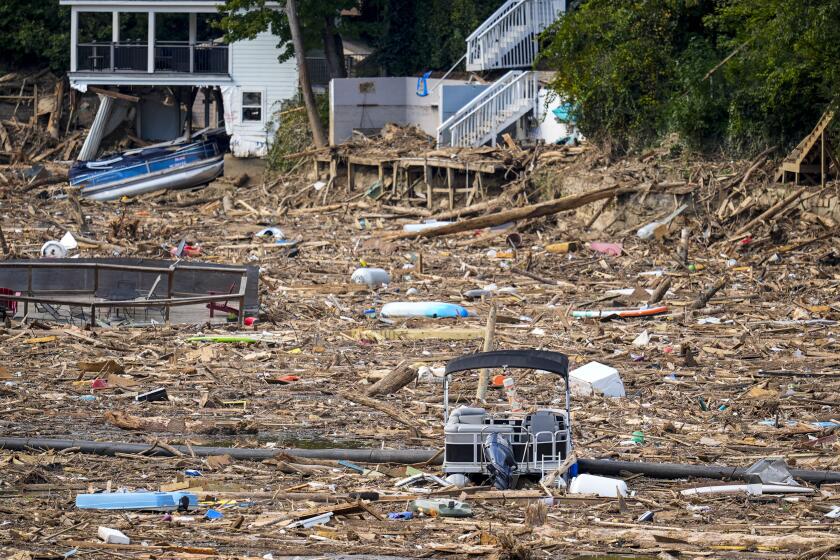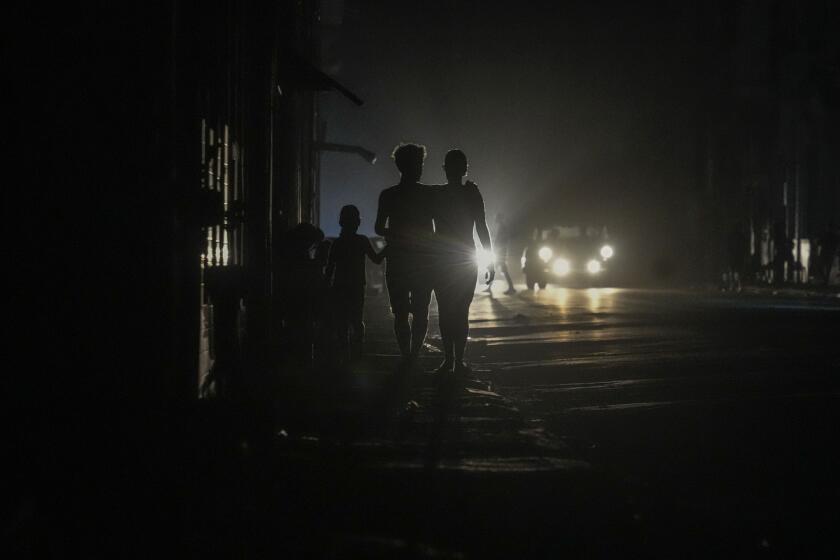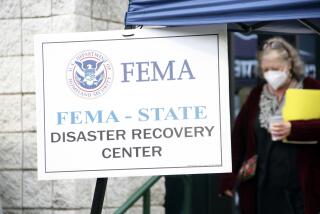Opinion: Hurricane misinformation is coming at a dangerous time

- Share via
With about six weeks remaining in this year’s Atlantic hurricane season, we’ve already experienced multiple historic storms, vividly illustrating that as humans have warmed the planet, we have also made it more dangerous.
Beryl became a Category 5 hurricane in July, the earliest in the calendar year that any Atlantic hurricane on record has reached that magnitude; Helene yielded catastrophic flooding and damage from Florida to western North Carolina; Kirk traversed the Atlantic to bring damaging rain and winds to France; Milton — one of the fastest-intensifying storms on record — caused damage across Florida; and Oscar surprised forecasters this weekend by quickly becoming a hurricane and dumping flooding rains in the Caribbean. The 2024 Atlantic hurricane season has made it abundantly clear that the consequences of climate change are here.
This hurricane season has also amplified another disturbing trend: misinformation about catastrophic weather extremes. For example, social media users have falsely claimed that Hurricanes Helene and Milton were created or steered by human technology. Such lies generate mistrust and anger, which are too often directed at meteorologists who work to save lives by providing accurate scientific forecasts warning those in harm’s way to evacuate.
The hurricane leveled Asheville and other towns in western North Carolina. The push for optimism about our climate future rings hollow right now.
Technology capable of creating or steering hurricanes does not exist outside of science fiction, or perhaps the lairs of cartoon villains. Humans shape extreme weather in another way: When we burn fossil fuels such as oil and gas, we release heat-trapping greenhouse gases that act as a blanket abnormally warming our planet. Scientists know that this human-caused warming is the real reason hurricanes such as Helene and Milton have become more dangerous.
This is where we need to focus our conversation — on understanding how climate change is making these extremes more dangerous, learning what we can do to limit further warming, and identifying ways to solve this human-caused crisis.
Climate change makes hurricanes more dangerous in several ways. For example, as we heat the planet, sea levels rise because glaciers and ice caps melt and water expands at warmer temperatures. This raises typical coastal water levels and gives a head start to storm surge flooding, as was the case along Florida’s coasts with Helene and Milton. Because of sea-level rise, that flooding becomes more damaging than it would have been in the past.
A warmer planet also increases the potential for extreme rainfall from hurricanes. A warmer atmosphere can hold more moisture, which can in turn intensify both the rates and amounts of rainfall. As we saw with Hurricane Helene, the resulting moisture can be not just damaging, but deadly.
Havana was partially illuminated Monday night after the large-scale blackout generated protests and a stern government warning against any unrest.
A warmer planet also means warmer oceans that in effect provide fuel to hurricanes, enabling them to reach greater strengths faster than would have otherwise been possible. My own research shows that, compared to 50 years ago, today’s storms are two to three times more likely to strengthen from Category 1 or less into a major hurricane (meaning Category 3 or greater) within 12 to 24 hours.
We’ve seen that play out in real time this year. Beryl, Helene and Milton all strengthened from weak hurricanes into major ones within 12 hours as they traveled over unnaturally warm ocean waters. Hurricane Milton strengthened especially fast, intensifying at rates across both a 12-hour and a 24-hour window that ranked above the 99th percentile compared with Atlantic hurricanes recorded from 1851 to 2023.
So the bad news is that we are making hurricanes worse. But the good news is, since we created this problem, we can also solve it. Generating fantastical lies about weather manipulation technology won’t prevent these growing coastal hazards, much as threatening meteorologists won’t make these storms less damaging. Actual solutions include developing better coastal defenses and emergency action plans and working to eliminate fossil fuel use across our economies.
A recent survey from the United Nations Development Programme shows that this is precisely what people all over the world, including the U.S., want. According to the study, two-thirds of Americans — and 80% of people around the world — think schools should teach more about climate change and its impacts. Two-thirds of Americans also want our country to strengthen commitments to address climate change, and more than half agree that we should quickly replace fossil fuels with renewable energy. A vast majority of Americans (80%) agree that we should work with other countries to combat climate change even if we disagree with them on other issues.
Although extreme weather has become more common, so too has the desire for meaningful climate action, which is the only viable option for sustaining our coastal communities. The task is difficult but not impossible. By understanding the impacts of climate change, sharing that information with each other and voting for leaders who will invest in successful solutions, we can secure a better future and prevent misinformation from defining our new reality.
Andra Garner is an associate professor and climate scientist in the department of environmental science at Rowan University in New Jersey.
More to Read
A cure for the common opinion
Get thought-provoking perspectives with our weekly newsletter.
You may occasionally receive promotional content from the Los Angeles Times.












